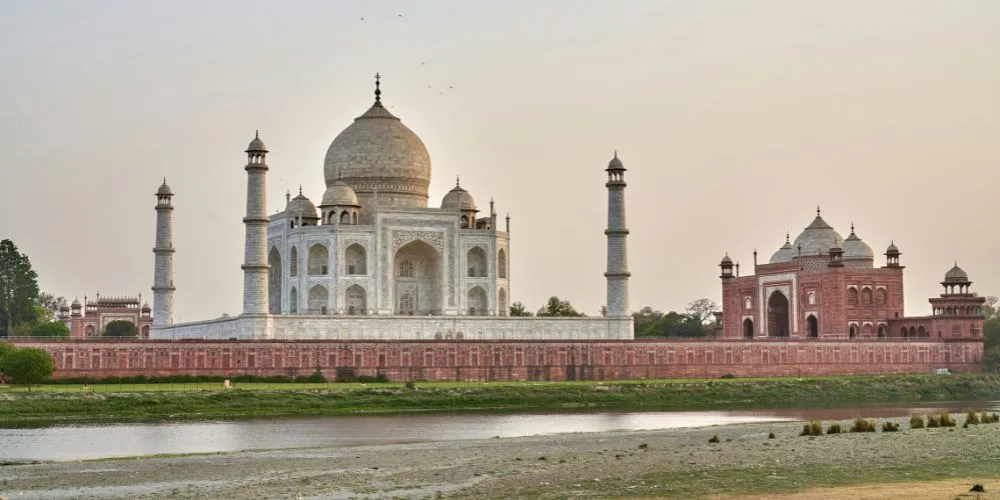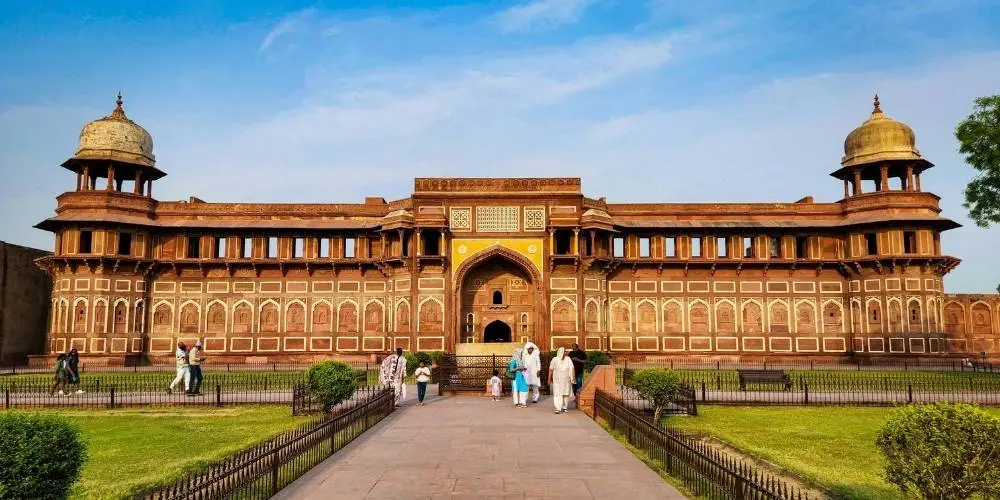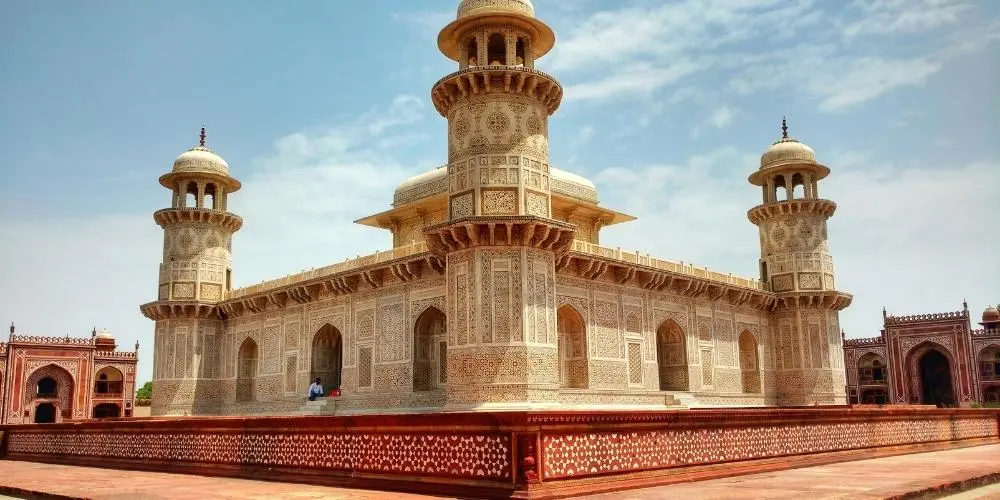Agra stands as a living reminder of India’s royal past, where the white marble dream of the Taj Mahal rises above the Yamuna river and narrates to the world the undying love story of Mumtaz Begum and Shah Jahan. But if you look closely, you’ll discover that Agra is not just about one monument. It’s an exciting mosaic of bustling markets, Persian gardens, historical forts, street food, and old-world charm. If there’s a city that is both familiar and full of surprises, it’s Agra.
How to Reach Agra: Road from Delhi to the City of Wonders
Agra’s proximity to the capital is a huge advantage for travellers. The Delhi to Agra distance is about 210-230 km, easily covered in 2.5-4 hours by car or bus via the speedy Yamuna Expressway. There are also multiple fast trains, most famously the Gatimaan Express, which brings you from Delhi to Agra Cantt station in just under two hours. Buses, cabs and even day packages are plentiful for those who want to keep things hassle-free. While there’s an airport in Agra, most visitors choose the road or rail route due to better connectivity.
Pro Tip: Start early from Delhi, enjoy a breakfast stop at a highway dhaba and reach Agra in time for the Taj’s morning magic!
Taj Mahal: One of the Seven Wonders of the World
When people across the globe think of Agra, it’s always the Taj Mahal; a UNESCO World Heritage masterpiece, one of the Seven Wonders of the World, and truly the city’s heartbeat. Built by Shah Jahan in memory of Mumtaz, its shimmering white marble and perfect symmetry draw millions every year.

Come at sunrise for the gentlest light, or stay till sunset and watch the monument blush pink. Roam the lush Charbagh (four-part garden), stand by the reflecting pool for that Insta-perfect snap, and listen to stories from local guides who know every marble secret of the Taj.
Note: The Taj Mahal is closed on Fridays to general visitors, so plan accordingly.
Places to Visit in Agra: Beyond the Taj
- Agra Fort: Just 2.5 km from the Taj, this red sandstone fort was both palace and stronghold for Akbar, Jahangir, and Shah Jahan. Wander through Diwan-e-Khas, Sheesh Mahal, and the high ramparts with Taj views.

- Mehtab Bagh: To photograph the Taj across the Yamuna, this lush Mughal garden is your perfect spot. The sunset view is pure romance, minus the crowd.
- Itimad-ud-Daula (Baby Taj): Often called the “jewel box,” this elegant marble tomb predates the Taj and boasts intricate inlay work and Mughal symmetry.

- Fatehpur Sikri: About 35 km from Agra, this abandoned Mughal capital is a huge site packed with halls, mosques, palaces, and the iconic Buland Darwaza.
- Akbar’s Tomb, Sikandra: A serene, atmospheric spot on the city’s northern edge.
- Mosques and Bazaars: Don’t miss Jama Masjid and the vibrant Sadar Bazaar for shopping.
- Wildlife SOS Bear Sanctuary: Perfect for animal lovers or families wanting a break from monuments.
- Chini Ka Rauza: A tomb built for a Persian poet with stunning tilework.
- Gurudwara Guru Ka Tal: A serene Sikh shrine in a city known for the Mughal architecture.
Where to Stay: Best Properties by the Taj
Agra’s most prized hotels are clustered around the Taj Ganj area for easy access:
- The Oberoi Amarvilas: Unbeatable for luxury and direct Taj views; every room has a view, and buggy rides take you right to the gates.
- Taj Hotel & Convention Centre: Plush, modern, a rooftop pool and Taj-facing suites.
- ITC Mughal: Lots of gardens, pools, a grand spa, and Mughal-style opulence.
- Hotel Sheela, Hotel Kamal, and Joey’s Hostel: Top value for money, located within walking distance to the monument for budget travellers.
- Boutique Hotels and Homestays: You’ll find many warm options near Fatehabad Road and Taj Ganj, some with family meals included. For heritage lovers, try Zeebee’s Guest House or Coral Tree Homestay for warmth and local colour.
What and Where to Eat
Foodies, rejoice! Agra is more than petha and dalmoth.
- Dasaprakash: Legendary for hygienic, delicious South Indian thalis.
- Peshawri at ITC Mughal: Tandoori excellence, kebabs, and breads that are truly royal in taste.
- Esphahan at the Oberoi: For fine Mughlai dining in lush surroundings.
- Mama Franky, Sadar Bazaar: Known for best chicken kebabs and spicy rolls.
- Good Vibes Café: Popular among young travellers for Italian, coffee, and rooftop chats.
- Local Delight: For street snacks, stop at Deviram Sweets for bedai (kachori), Rambabu Paratha Bhandar for parathas, and Panchhi Petha for that sweet, glazed classic Agra treat.
Best Time to Visit Agra
The absolute best time to visit Agra is from November to February. The air is cool and crisp, making sightseeing pleasant throughout the day. From March to June, the city can get scorching hot, while July to September brings humidity and monsoon showers; less ideal, unless you enjoy rain and fewer crowds.
Do plan both sunrise and late afternoon visits to the Taj for the most stunning experience; carry a light jacket in winter for misty mornings.
Travel Tips
- Dress modestly out of respect for local customs, especially at mosques and temples.
- Carry a refillable water bottle, hat, and sunscreen; the sun gets strong especially during summers.
- Try local e-rickshaws or hired cabs for sightseeing circuits.
- Book Taj tickets online or at the ASI counter to avoid long queues, and use the free cloakroom for bags (not allowed inside the monument).
- Carry cash for bazaars; many shops don’t accept cards.
Next Journey: Road Tripping from Agra
Agra sits perfectly for travel onward to Jaipur (260 km), Bharatpur Bird Sanctuary (56 km), or the spiritual delight of Mathura-Vrindavan (65 km). The city’s strategic location makes it an ideal part of the Golden Triangle circuit with Delhi and Jaipur.
Agra is more than a monument; it’s a living, breathing city of stories, flavours, and colours. Come for the Taj, stay for the history, and leave with your own memory of this city of a world wonder and testament of love.
By: Anushka Singhal
